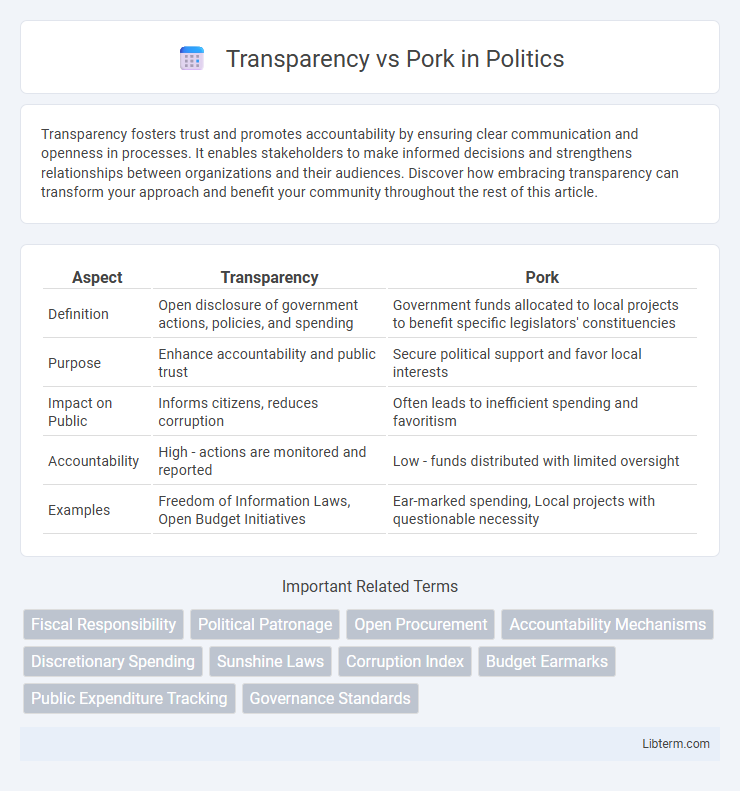Transparency fosters trust and promotes accountability by ensuring clear communication and openness in processes. It enables stakeholders to make informed decisions and strengthens relationships between organizations and their audiences. Discover how embracing transparency can transform your approach and benefit your community throughout the rest of this article.
Table of Comparison
| Aspect | Transparency | Pork |
|---|---|---|
| Definition | Open disclosure of government actions, policies, and spending | Government funds allocated to local projects to benefit specific legislators' constituencies |
| Purpose | Enhance accountability and public trust | Secure political support and favor local interests |
| Impact on Public | Informs citizens, reduces corruption | Often leads to inefficient spending and favoritism |
| Accountability | High - actions are monitored and reported | Low - funds distributed with limited oversight |
| Examples | Freedom of Information Laws, Open Budget Initiatives | Ear-marked spending, Local projects with questionable necessity |
Understanding Transparency in Governance
Understanding transparency in governance involves the clear disclosure of decision-making processes, financial allocations, and policy implementations to the public. Transparency reduces corruption by enabling citizens to monitor government actions and hold officials accountable for misuse of funds, commonly known as pork-barrel spending. Enhanced openness fosters trust, improves resource allocation, and strengthens democratic institutions through informed civic engagement.
Defining Pork Barrel Practices
Pork barrel practices involve the allocation of government funds to local projects primarily aimed at benefiting a legislator's constituents to secure political support rather than addressing broader public policy needs. Transparency in government spending requires clear disclosure and accountability mechanisms that reveal how and why funds are distributed, exposing pork barrel allocations to public scrutiny. Defining pork barrel practices helps differentiate between essential localized investments and wasteful, politically motivated expenditures, promoting more efficient and ethical governance.
The Historical Context: Transparency vs Pork
Transparency in government spending emerged as a response to the historical prevalence of pork-barrel politics, where legislators secured specific funds for local projects to benefit their constituencies. During the progressive era and subsequent reforms, transparency initiatives aimed to curb the misuse of public funds and reduce corruption by making budget allocations and expenditures publicly accessible. The ongoing tension reflects a balancing act between democratic accountability and the political realities of constituency service through targeted appropriations.
Impacts of Transparency on Public Trust
Transparency in government spending significantly enhances public trust by reducing perceptions of corruption and misuse of funds. Access to clear and detailed budget information empowers citizens to hold officials accountable, fostering a more informed and engaged electorate. Higher transparency levels correlate with increased confidence in public institutions and improved democratic governance.
Pork Barrel: Corruption and Misallocation Risks
Pork barrel spending often leads to corruption and misallocation of public funds, diverting resources to politically motivated projects rather than community needs. This practice undermines transparency by obscuring the decision-making process and enabling favoritism among legislators. Effective governance requires mechanisms to detect and prevent pork barrel allocations to ensure accountability and optimal use of taxpayer money.
Key Differences Between Transparency and Pork
Transparency ensures open access to information, allowing stakeholders to monitor government actions and spending, promoting accountability and trust. Pork, or pork-barrel spending, involves allocating government funds for localized projects intended to benefit specific constituencies, often criticized for lack of transparency and potential misuse of public resources. The key difference lies in transparency fostering clear, public visibility of expenditures, while pork typically obscures true budgetary priorities and favors political gains over broader public interest.
Case Studies: Countries’ Experiences
Countries like South Korea and Brazil demonstrate how transparency in budget processes reduces pork-barrel spending by enabling public scrutiny and accountability. Case studies reveal that nations with strong transparency laws and open data initiatives report lower incidences of misallocated government funds and increased public trust. Conversely, countries lacking transparency often face persistent pork-barrel politics, undermining governance and economic development.
Legal Frameworks Promoting Transparency
Legal frameworks promoting transparency, such as the Freedom of Information Act (FOIA) and anti-corruption laws, establish mandates for public access to government records and disclosure of political spending. These laws enhance accountability by requiring detailed reporting of lobbying activities, campaign finance, and procurement processes, reducing opportunities for pork-barrel spending. Enforcement mechanisms, including independent oversight bodies and whistleblower protections, are integral to ensuring compliance and fostering an open government environment.
The Role of Technology in Enhancing Transparency
Technology plays a pivotal role in enhancing transparency by enabling real-time data access and increasing accountability in government spending. Advanced digital platforms and blockchain systems provide secure, immutable records that expose pork-barrel allocations and reduce corruption risks. Enhanced transparency fosters public trust and facilitates informed citizen participation in decision-making processes.
Strategies to Combat Pork Barrel Politics
Implementing open budget systems and real-time public expenditure tracking enhances transparency and reduces opportunities for pork barrel politics. Strengthening independent auditing bodies and enforcing strict anti-corruption laws deter misuse of public funds by holding officials accountable. Encouraging citizen participation through digital platforms fosters oversight and pressurizes policymakers to allocate resources based on merit and public needs.
Transparency Infographic

 libterm.com
libterm.com